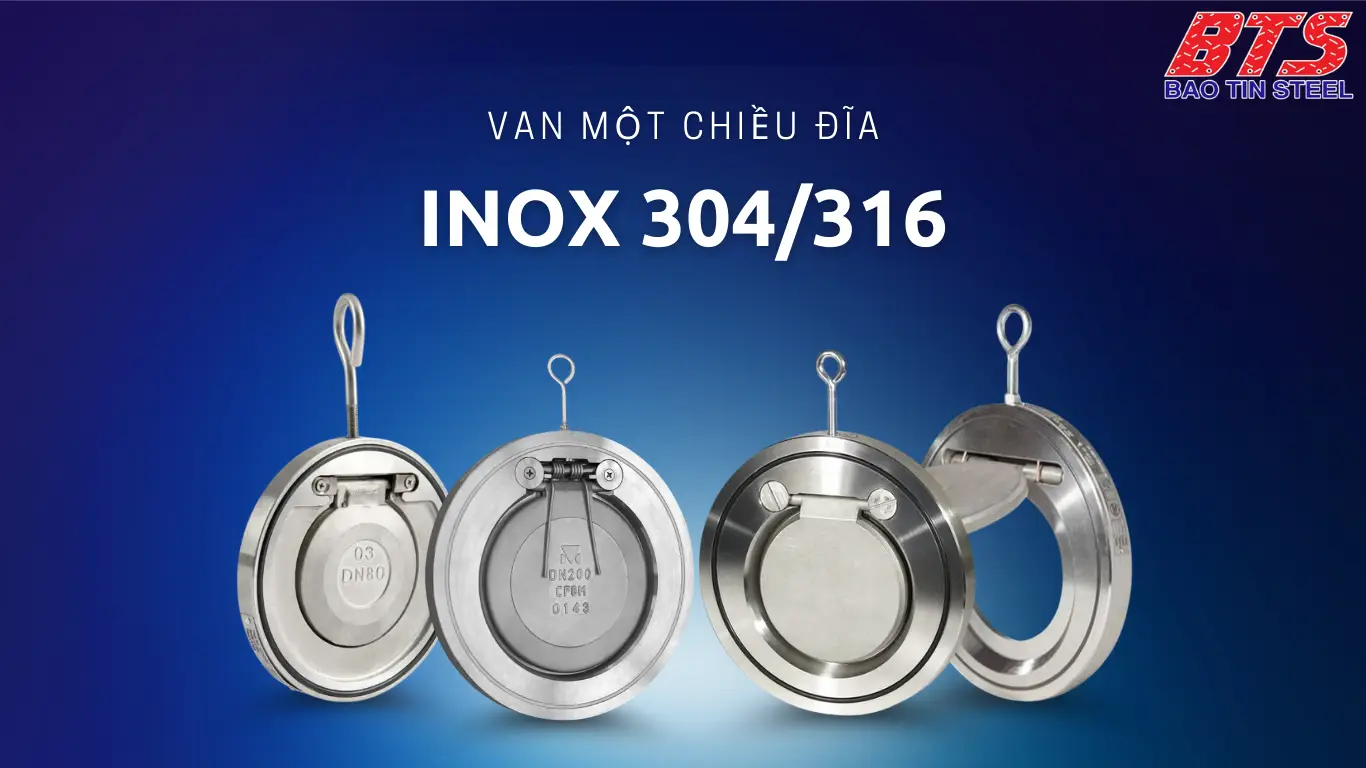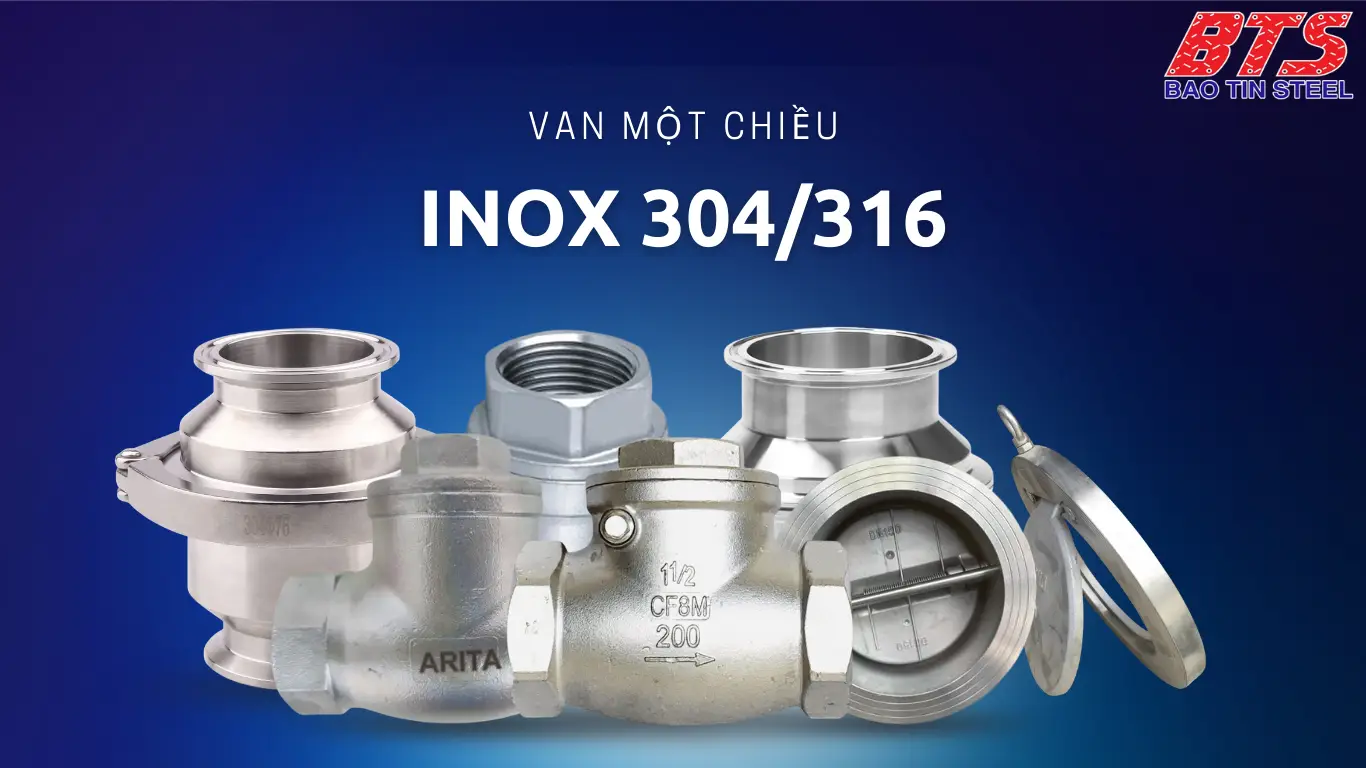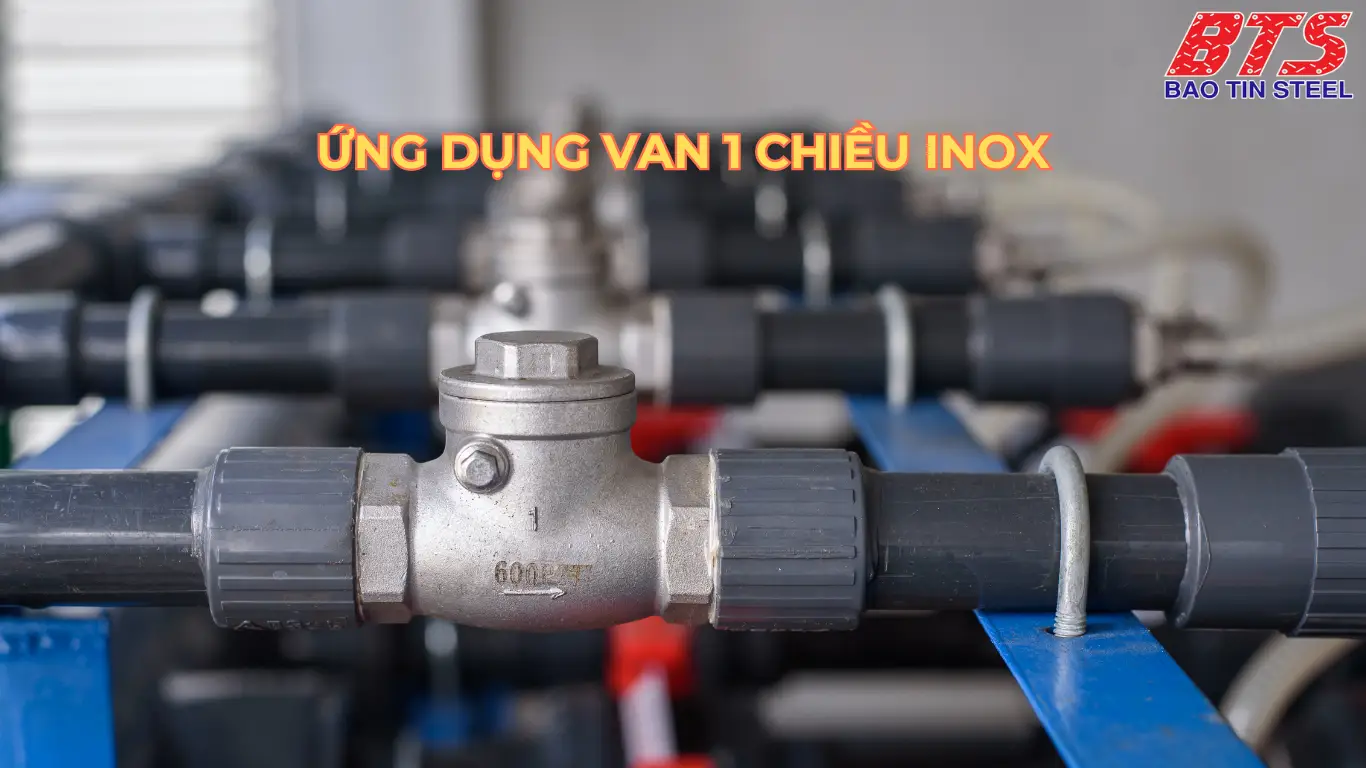Compared to valves made from cast iron or brass, stainless steel check valves stand out for their high durability, corrosion resistance, and ability to withstand extreme pressure and temperature. For this reason, types such as 304 stainless steel swing check valves, spring check valves, and wafer check valves are widely used in various systems — from water supply and drainage, fire protection, and chemical processing to food and pharmaceutical industries.
In this article, Bao Tin Steel will guide you through a detailed comparison between 304 and 316 stainless steel check valves, help you decide whether to choose a swing, spring, or wafer type for your system, provide the latest 2025 stainless steel check valve price list, and suggest trusted suppliers of stainless steel check valves in Ho Chi Minh City.
Common Types of Stainless Steel Check Valves
Currently, the market offers many types of stainless steel check valves, each with its own structure and advantages. Below are the most common types you should know before making a selection:
Stainless Steel Swing Check Valve
This is the most commonly used type, often referred to as the 304 stainless steel swing check valve. Its structure includes a disc mounted on a hinge pin; when the fluid flows in the correct direction, the disc swings open. Conversely, when the flow stops or reverses, the disc automatically closes to prevent backflow

- Advantages: Simple structure, affordable price, and low pressure loss.
Disadvantages: Can only be installed horizontally; large valves may cause water hammer.
Applications: Water supply and drainage systems, wastewater treatment, and oil & gas industries.
=> Learn more: What is a check valve? Structure, principle and installation
Stainless Steel Spring Check Valve
Also known as a stainless steel spring-type check valve, this valve uses the compression force of a spring to close the valve. When the fluid flow reaches sufficient pressure, the spring compresses, allowing the fluid to pass through.
- Advantages: Quick shut-off, minimises water hammer, can be installed both horizontally and vertically.
- Disadvantages: Slight pressure drop due to spring resistance, higher cost compared to swing check valves.
- Applications: Booster pump systems, compressed air, and hot water systems.
=> Learn more: Spring check valve – Classification, applications and how to choose the right one
Stainless Steel Dual Plate Check Valve
Often referred to as a stainless steel butterfly check valve, this type features two semicircular plates that open and close like butterfly wings when fluid flows through.

- Advantages: Compact design, lightweight, reduces pressure loss.
- Disadvantages: Not completely leak-proof, prone to jamming if debris is present.
- Applications: HVAC systems, fire protection, water supply and drainage, and large-diameter pipelines.
Stainless Steel Wafer/Lift Check Valve
This type, also known as a wafer-type check valve, is commonly used in tight spaces. The valve disc opens and closes quickly with the help of a spring.

- Advantages: Fast response, minimises water hammer, and easy to install.
- Disadvantages: Not suitable for very high-pressure systems, limited availability in large sizes.
- Applications: HVAC systems, water treatment, compressed air.
Advantages & Disadvantages of Stainless Steel Check Valves
When selecting equipment for a piping system, you naturally want to know whether a stainless steel check valve is truly worth the investment. Let’s go through the key advantages and disadvantages of Thép Bảo Tín.
Key Advantages
- Excellent corrosion and rust resistance: Made from 304 or 316 stainless steel, these valves can operate reliably in water, steam, and even chemical or seawater environments.
- High durability and long service life: Compared to cast iron or brass valves, stainless steel check valves are less prone to damage, helping you save on maintenance and replacement costs.
- Automatic and safe operation: The valves open and close entirely based on fluid flow pressure, requiring no electricity or manual operation.
- Versatile applications: Types such as 304 stainless steel swing check valves, spring check valves, and butterfly check valves can be used in a wide range of systems, from water supply and fire protection to the food and pharmaceutical industries.
Disadvantages to Note
Higher cost: Compared to cast iron, plastic, or brass valves, stainless steel check valves have a higher initial investment. However, this is offset by their superior durability and safety.
Slight pressure drop in some types: For example, stainless steel spring check valves may cause a minor flow resistance due to the spring’s compression force.
Stainless Steel Materials Used for Check Valves
When researching stainless steel check valves, you will likely encounter grades such as 201, 304, or 316 stainless steel. These are the stainless steel grades used to manufacture the valve body, each with its own characteristics in terms of durability, corrosion resistance, and cost.

201 Stainless Steel Check Valve
- Characteristics: Low nickel content (around 4.5%), with a higher proportion of manganese.
- Advantages: The most cost-effective option in the stainless steel group, while still providing good mechanical strength.
- Disadvantages: Poor corrosion resistance, not suitable for seawater or chemical environments.
- Applications: Recommended only for general environments with minimal exposure to chemicals or corrosive substances.
304 Stainless Steel Check Valve
- Characteristics: The most common grade today, containing over 8% nickel and about 18% chromium, providing excellent corrosion resistance.
- Advantages: Balances cost and quality, withstands high pressure and temperature, suitable for most industrial systems.
- Disadvantages: Less durable than 316 stainless steel in seawater or strong chemical environments.
- Applications: Water supply and drainage, fire protection systems, compressed air systems, and food and beverage industries.
316 Stainless Steel Check Valve
- Characteristics: Higher-grade than 304 stainless steel due to the addition of 2–3% Molybdenum (Mo).
- Advantages: Outstanding corrosion resistance, especially in chloride-containing environments (such as seawater, acids, and chemical solutions). Can withstand temperatures up to 870°C.
- Disadvantages: The Highest cost among stainless steel grades, but essential for harsh environments.
- Applications: Chemical plants, coastal constructions, pharmaceutical and high-end food industries.
Practical Applications of Stainless Steel Check Valves
Thanks to their durability, corrosion resistance, and automatic safe operation, stainless steel check valves are widely used across various industries. Here are some practical applications:
- Installed after pumps in water treatment plants, residential projects, and wastewater drainage systems.
- Used in fire sprinkler systems, booster pump stations, and HVAC systems (heating, ventilation, and air conditioning).
- 316 stainless steel check valves are applied in chemical plants, coastal constructions, and oil & gas pipelines.
- Sanitary stainless steel check valves made from 304 or 316L stainless steel are commonly used in production lines for drinking water, pharmaceuticals, cosmetics, and biotechnology, including breweries, dairy plants, beverage production, and pharmaceutical manufacturing.

Selection Criteria & Installation Considerations
Choosing the right type of stainless steel check valve not only ensures stable system operation but also helps you save long-term maintenance costs. Here are some important criteria to consider:
Selection Criteria
1. Fluid and Operating Environment
- For clean water or compressed air, a 304 stainless steel check valve is suitable.
- For chemical systems or seawater, 316 stainless steel check valves are recommended for superior corrosion resistance.
2. Pressure and Pipe Size (PN & DN)
- Select the correct PN (nominal pressure) and DN (pipe diameter).
- Example: For a DN50 pipe, choose a valve with DN50, PN16.
3. Connection Type
- Threaded connection: Compact, suitable for DN15–DN50 pipes.
- Flanged connection: Strong and secure, suitable for DN50 pipes and above.
- Wafer or clamp connection: Lightweight, easy to install/remove, commonly used in sanitary systems.
4. Valve Operation Mechanism
- Quick shut-off required: Choose a spring check valve.
- Large pipe, cost-effective solution: Choose a swing check valve.
- Tight space, compact design: Choose a butterfly check valve.
Installation Considerations
- Install according to flow direction: There is always an arrow on the valve body indicating the flow direction; the valve must be installed following this direction.
- Avoid pipe load on the valve: For large valves, use a separate support to prevent stress from the piping system.
- Installation position:
-
-
Swing check valves are generally suitable for horizontal pipes only.
-
Spring check valves can be installed both horizontally and vertically.
-
Regular maintenance: Even though the valves operate automatically, you should still inspect gaskets, valve discs, and springs periodically to ensure tight sealing and long service life.
Latest stainless steel check valves price 2025
| Valve Type | Size | Origin | Reference Price (VND) |
|---|---|---|---|
| Stainless Steel Swing Check Valve | DN125 | South Korea | ~2,400,000 |
| Stainless Steel Spring Check Valve | DN50 | China | ~260,000 |
| Stainless Steel Butterfly Check Valve | DN50 | South Korea | ~490,000 |
| Stainless Steel Dual Plate Check Valve | DN50 | Domestic | ~700,000 |
| Stainless Steel Wafer Check Valve | DN65 | Domestic | ~370,000 |
The prices listed are for reference only. Depending on the project, order quantity, and technical requirements, the actual price may vary. For the most accurate stainless steel check valves price list, please don’t hesitate to contact Bao Tin Steel directly via our hotline at 0932 059 176.
Through this article, you should now have a better understanding of stainless steel check valves. If you are looking for a reliable supplier of genuine stainless steel check valves, complete with CO–CQ, competitive prices, and dedicated technical support, let Bao Tin Steel accompany you every step of the way.
Bao Tin Steel Commitment:
- Supply a wide range of stainless steel check valves: swing, spring, butterfly, wafer, and sanitary types.
- Genuine products with clear certification.
- Quick and accurate price quotes tailored to your needs.
- Nationwide delivery with attentive after-sales service.
Contact us today to receive the latest 2025 stainless steel check valve price list and get advice on the best solutions for your system!


 Tiếng Việt
Tiếng Việt ភាសាខ្មែរ
ភាសាខ្មែរ